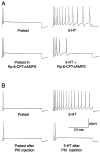Activation of protein kinase A contributes to the expression but not the induction of long-term hyperexcitability caused by axotomy of Aplysia sensory neurons
- PMID: 9952402
- PMCID: PMC6786014
- DOI: 10.1523/JNEUROSCI.19-04-01247.1999
Activation of protein kinase A contributes to the expression but not the induction of long-term hyperexcitability caused by axotomy of Aplysia sensory neurons
Abstract
Nociceptive sensory neurons (SNs) in Aplysia provide useful models to study both memory and adaptive responses to nerve injury. Induction of long-term memory in many species, including Aplysia, is thought to depend on activation of cAMP-dependent protein kinase (PKA). Because Aplysia SNs display similar alterations in models of memory and after nerve injury, a plausible hypothesis is that axotomy triggers memory-like modifications by activating PKA in damaged axons. The present study disproves this hypothesis. SN axotomy was produced by (1) dissociation of somata from the ganglion [which is shown to induce long-term hyperexcitability (LTH)], (2) transection of neurites of dissociated SNs growing in vitro, or (3) peripheral nerve crush. Application of the competitive PKA inhibitor Rp-8-CPT-cAMPS at the time of axotomy failed to alter the induction of LTH by each form of axotomy, although the inhibitor antagonized hyperexcitability produced by 5-HT application. Strong activation of PKA in the nerve by coapplication of a membrane-permeant analog of cAMP and a phosphodiesterase inhibitor was not sufficient to induce LTH of either the SN somata or axons. Furthermore, nerve crush failed to activate axonal PKA or stimulate its retrograde transport. Therefore, PKA activation plays little if any role in the induction of LTH by axotomy. However, the expression of LTH was reduced by intracellular injection of the highly specific PKA inhibitor PKI several days after nerve crush. This suggests that long-lasting activation of PKA in or near the soma contributes to the maintenance of long-term modifications produced by nerve injury.
Figures








Similar articles
-
Cellular, molecular, and epigenetic mechanisms in non-associative conditioning: implications for pain and memory.Neurobiol Learn Mem. 2013 Oct;105:133-50. doi: 10.1016/j.nlm.2013.06.008. Epub 2013 Jun 22. Neurobiol Learn Mem. 2013. PMID: 23796633 Free PMC article. Review.
-
Evidence that long-term hyperexcitability of the sensory neuron soma induced by nerve injury in Aplysia is adaptive.J Neurophysiol. 2005 Sep;94(3):2218-30. doi: 10.1152/jn.00169.2005. Epub 2005 Jun 8. J Neurophysiol. 2005. PMID: 15944238
-
Limited contributions of serotonin to long-term hyperexcitability of Aplysia sensory neurons.J Neurophysiol. 1999 Dec;82(6):3223-35. doi: 10.1152/jn.1999.82.6.3223. J Neurophysiol. 1999. PMID: 10601456
-
Serotonin induces memory-like, rapamycin-sensitive hyperexcitability in sensory axons of aplysia that contributes to injury responses.J Neurophysiol. 2007 Sep;98(3):1231-9. doi: 10.1152/jn.01189.2006. Epub 2007 Jul 18. J Neurophysiol. 2007. PMID: 17634332
-
Multiple serotonergic mechanisms contributing to sensitization in aplysia: evidence of diverse serotonin receptor subtypes.Learn Mem. 2003 Sep-Oct;10(5):373-86. doi: 10.1101/lm.66103. Learn Mem. 2003. PMID: 14557610 Free PMC article. Review.
Cited by
-
A neuronal isoform of protein kinase G couples mitogen-activated protein kinase nuclear import to axotomy-induced long-term hyperexcitability in Aplysia sensory neurons.J Neurosci. 2004 Aug 25;24(34):7583-95. doi: 10.1523/JNEUROSCI.1445-04.2004. J Neurosci. 2004. PMID: 15329406 Free PMC article.
-
Action potential-independent spontaneous microdomain Ca2+ transients-mediated continuous neurotransmission regulates hyperalgesia.Proc Natl Acad Sci U S A. 2025 Jan 21;122(3):e2406741122. doi: 10.1073/pnas.2406741122. Epub 2025 Jan 17. Proc Natl Acad Sci U S A. 2025. PMID: 39823298 Free PMC article.
-
Cellular, molecular, and epigenetic mechanisms in non-associative conditioning: implications for pain and memory.Neurobiol Learn Mem. 2013 Oct;105:133-50. doi: 10.1016/j.nlm.2013.06.008. Epub 2013 Jun 22. Neurobiol Learn Mem. 2013. PMID: 23796633 Free PMC article. Review.
-
The role of PKA and PKCepsilon pathways in prostaglandin E2-mediated hypernociception.Br J Pharmacol. 2009 Mar;156(5):826-34. doi: 10.1111/j.1476-5381.2008.00093.x. Epub 2009 Feb 13. Br J Pharmacol. 2009. PMID: 19220288 Free PMC article.
-
Axonal rejoining inhibits injury-induced long-term changes in Aplysia sensory neurons in vitro.J Neurosci. 2001 Dec 15;21(24):9667-77. doi: 10.1523/JNEUROSCI.21-24-09667.2001. J Neurosci. 2001. PMID: 11739576 Free PMC article.
References
-
- Abel T, Kandel E. Positive and negative regulatory mechanisms that mediate long-term memory storage. Brain Res Brain Res Rev. 1998;26:360–378. - PubMed
-
- Alberini CM, Ghirardi M, Metz R, Kandel ER. C/EBP is an immediate-early gene required for the consolidation of long-term facilitation in Aplysia. Cell. 1994;76:1099–1114. - PubMed
-
- Ambron RT, Walters ET. Priming events and retrograde injury signals: a new perspective on the cellular and molecular biology of nerve regeneration. Mol Neurobiol. 1996;13:61–79. - PubMed
Publication types
MeSH terms
Substances
Grants and funding
LinkOut - more resources
Full Text Sources
Other Literature Sources
